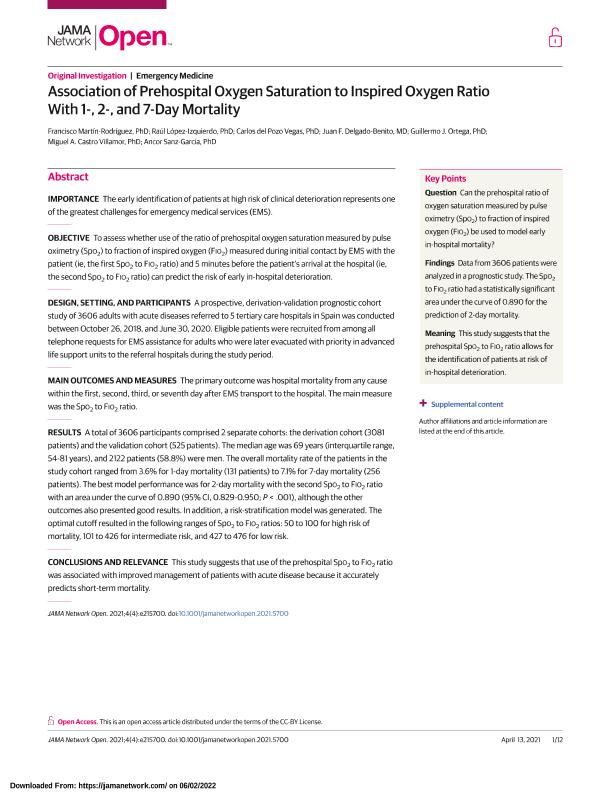Artículo
Association of Prehospital Oxygen Saturation to Inspired Oxygen Ratio with 1-, 2-, and 7-Day Mortality
Martín Rodríguez, Francisco; López Izquierdo, Raúl; Del Pozo Vegas, Carlos; Delgado Benito, Juan F.; Ortega, Guillermo José ; Castro Villamor, Miguel A.; Sanz García, Ancor
; Castro Villamor, Miguel A.; Sanz García, Ancor
 ; Castro Villamor, Miguel A.; Sanz García, Ancor
; Castro Villamor, Miguel A.; Sanz García, Ancor
Fecha de publicación:
04/2021
Editorial:
American Medical Association
Revista:
JAMA Network Open
ISSN:
2574-3805
e-ISSN:
2574-3805
Idioma:
Inglés
Tipo de recurso:
Artículo publicado
Clasificación temática:
Resumen
Importance: The early identification of patients at high risk of clinical deterioration represents one of the greatest challenges for emergency medical services (EMS). Objective: To assess whether use of the ratio of prehospital oxygen saturation measured by pulse oximetry (Spo2) to fraction of inspired oxygen (Fio2) measured during initial contact by EMS with the patient (ie, the first Spo2to Fio2ratio) and 5 minutes before the patient's arrival at the hospital (ie, the second Spo2to Fio2ratio) can predict the risk of early in-hospital deterioration. Design, Setting, and Participants: A prospective, derivation-validation prognostic cohort study of 3606 adults with acute diseases referred to 5 tertiary care hospitals in Spain was conducted between October 26, 2018, and June 30, 2020. Eligible patients were recruited from among all telephone requests for EMS assistance for adults who were later evacuated with priority in advanced life support units to the referral hospitals during the study period. Main Outcomes and Measures: The primary outcome was hospital mortality from any cause within the first, second, third, or seventh day after EMS transport to the hospital. The main measure was the Spo2to Fio2ratio. Results: A total of 3606 participants comprised 2 separate cohorts: the derivation cohort (3081 patients) and the validation cohort (525 patients). The median age was 69 years (interquartile range, 54-81 years), and 2122 patients (58.8%) were men. The overall mortality rate of the patients in the study cohort ranged from 3.6% for 1-day mortality (131 patients) to 7.1% for 7-day mortality (256 patients). The best model performance was for 2-day mortality with the second Spo2to Fio2ratio with an area under the curve of 0.890 (95% CI, 0.829-0.950; P <001), although the other outcomes also presented good results. In addition, a risk-stratification model was generated. The optimal cutoff resulted in the following ranges of Spo2to Fio2ratios: 50 to 100 for high risk of mortality, 101 to 426 for intermediate risk, and 427 to 476 for low risk. Conclusions and Relevance: This study suggests that use of the prehospital Spo2to Fio2ratio was associated with improved management of patients with acute disease because it accurately predicts short-term mortality.
Archivos asociados
Licencia
Identificadores
Colecciones
Articulos(SEDE CENTRAL)
Articulos de SEDE CENTRAL
Articulos de SEDE CENTRAL
Citación
Martín Rodríguez, Francisco; López Izquierdo, Raúl; Del Pozo Vegas, Carlos; Delgado Benito, Juan F.; Ortega, Guillermo José; et al.; Association of Prehospital Oxygen Saturation to Inspired Oxygen Ratio with 1-, 2-, and 7-Day Mortality; American Medical Association; JAMA Network Open; 4; 4; 4-2021; 1-12
Compartir
Altmétricas



